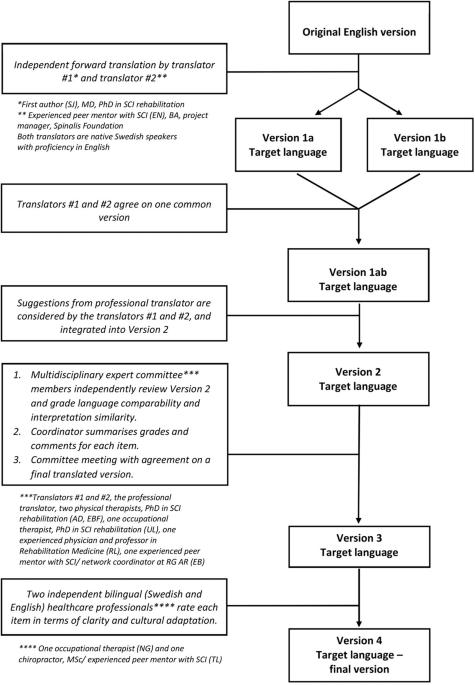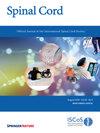瑞典语版莫荣自我效能感量表(s-MSES)--社区环境中的翻译过程和心理测量特性
IF 2.1
4区 医学
Q3 CLINICAL NEUROLOGY
引用次数: 0
摘要
研究设计心理计量学研究.目的 i) 描述翻译过程;ii) 探讨瑞典语版莫荣自我效能感量表(s-MSES)的数据完整性、目标性、可靠性和有效性.设置社区康复计划.方法纳入 92 名计划参与者和 42 名同伴指导者,他们都是脊髓损伤(SCI)患者,参加了积极康复训练计划(参加了国际积极康复评估项目(Inter-PEER))。s-MSES在线完成,项目参与者完成一次,同伴指导者完成两次。翻译过程以指南为基础,由研究人员、临床医生和消费者共同参与。91%的人获得了总分。不出所料,同伴指导者在所有分量表中都表现出了上限效应。总分的 Cronbach's alpha 为 0.92(分量表为 0.74-0.83)。总分和分量表得分的类内相关系数非常高(0.78-0.91)。s-MSES 对变化表现出敏感性,评估点之间没有系统性的变化。s-MSES 与生活满意度和复原力呈显著正相关,与抑郁/焦虑呈负相关。我们的结果证明了 s-MSES 的数据完整性、针对性、可靠性和有效性。因此,s-MSES 被认为适合用于评估社区康复环境中 SCI 患者的自我效能感。现在瑞典版的 MSES 将有助于国家研究、临床评估和国际比较。本文章由计算机程序翻译,如有差异,请以英文原文为准。


The Swedish version of the Moorong Self-Efficacy Scale (s-MSES) – translation process and psychometric properties in a community setting
Psychometric study. To i) describe the translation process and ii) explore the data completeness, targeting, reliability and aspects of validity of the Swedish version of Moorong Self-Efficacy Scale (s-MSES). Community rehabilitation program. Ninety-two program participants and 42 peer mentors with spinal cord injury (SCI) in Active Rehabilitation training programs (enrolled in the International Project for the Evaluation of activE Rehabilitation (Inter-PEER)) were included. The s-MSES was completed online, once for program participants and twice for peer mentors. The translation process was based on guidelines and involved researchers, clinicians and consumers. Minor linguistic adaptations were made. Ninety-one percent obtained a total score. As expected, peer mentors exhibited ceiling effects in all subscales. Cronbach´s alpha for the total scale was 0.92 (subscales 0.74–0.83). The intraclass correlation coefficient was excellent for the total and subscale scores (0.78–0.91). The s-MSES exhibited sensitivity to changes and there were no systematic changes between evaluation points. The s-MSES correlated significantly and positively with life satisfaction and resilience, and negatively with depression/anxiety. The s-MSES was translated through a rigorous, consumer-involved process ensuring accurate linguistic translation and cultural adaptation. Our results support the data completeness, targeting, reliability and aspects of validity of the s-MSES. The s-MSES can thus be considered suitable to assess self-efficacy in persons with SCI in community rehabilitation settings. The now available Swedish version of the MSES will facilitate national research, clinical evaluations and international comparisons. Not applicable.
求助全文
通过发布文献求助,成功后即可免费获取论文全文。
去求助
来源期刊

Spinal cord
医学-临床神经学
CiteScore
4.50
自引率
9.10%
发文量
142
审稿时长
2 months
期刊介绍:
Spinal Cord is a specialised, international journal that has been publishing spinal cord related manuscripts since 1963. It appears monthly, online and in print, and accepts contributions on spinal cord anatomy, physiology, management of injury and disease, and the quality of life and life circumstances of people with a spinal cord injury. Spinal Cord is multi-disciplinary and publishes contributions across the entire spectrum of research ranging from basic science to applied clinical research. It focuses on high quality original research, systematic reviews and narrative reviews.
Spinal Cord''s sister journal Spinal Cord Series and Cases: Clinical Management in Spinal Cord Disorders publishes high quality case reports, small case series, pilot and retrospective studies perspectives, Pulse survey articles, Point-couterpoint articles, correspondences and book reviews. It specialises in material that addresses all aspects of life for persons with spinal cord injuries or disorders. For more information, please see the aims and scope of Spinal Cord Series and Cases.
 求助内容:
求助内容: 应助结果提醒方式:
应助结果提醒方式:


